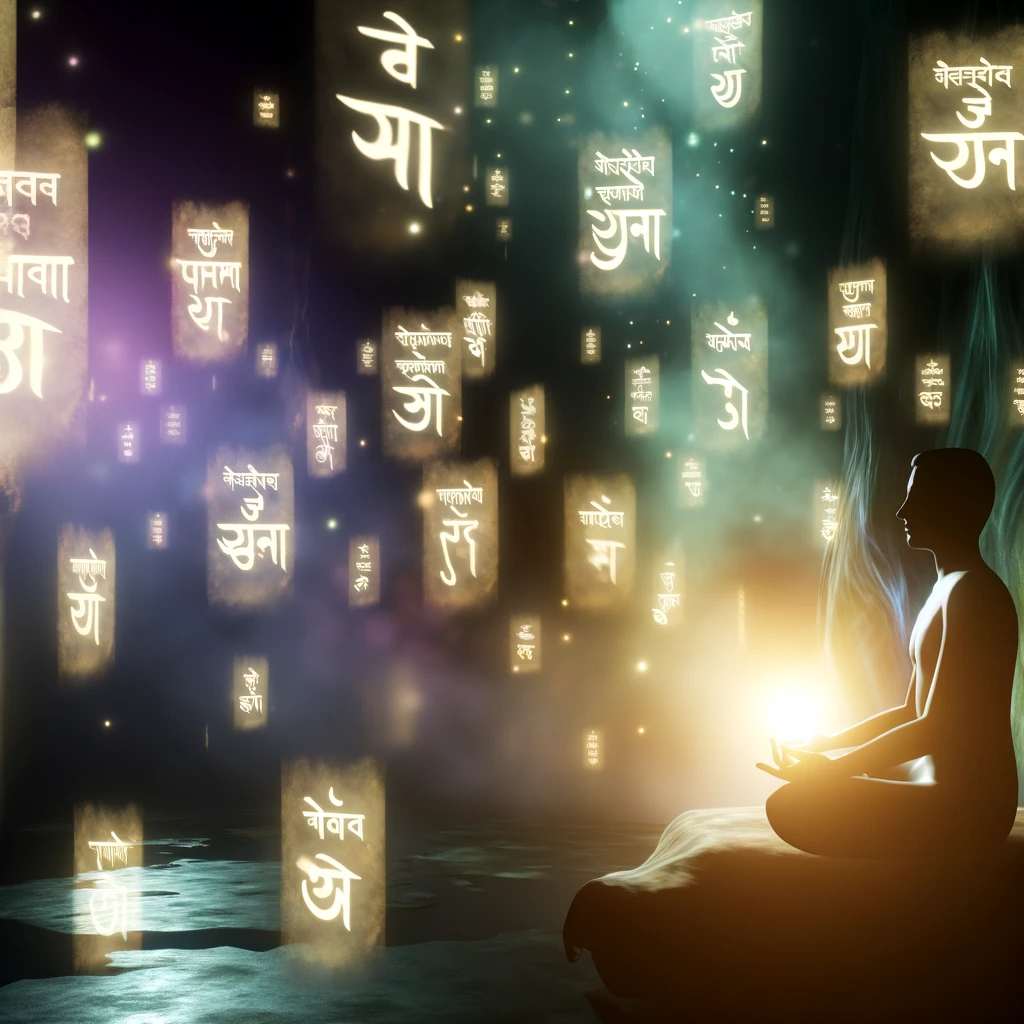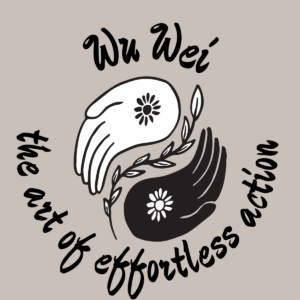Get ready to embark on a trip of inner peace and tranquility with mantra meditation – your ticket to a calmer, more centered you awaits!
In a world buzzing with chaos and noise, taking a moment to pause, breathe, and align your energies can work wonders. And one of the best ways to accomplish this is through the enchanting practice of mantra meditation.
Welcome to the realm where ancient wisdom meets modern serenity, and the power of energetic essence intertwines with consciousness to create a symphony of bliss. In this in-depth guide, we’ll dive into the transformative world of mantras, including:
- What is a mantra
- The history of mantras
- How are mantras useful
- Types of mantras and how to choose them
- Developing a mantra practice
Come with me as we unravel the secrets of mantra practice and explore meditation techniques that’ll have you floating on the clouds.
What is a Mantra?

Mantra is a Sanskrit word. It comes from the Sanskrit “man,” meaning mind, and “tra,” meaning tool. So, it is a “tool of the mind.”
I find it so interesting and helpful to think of a mantra as a literal tool, just like a hammer or screwdriver. It’s something we can use to our advantage to make a particular project or undertaking easier.
In Vedic philosophy, the mantra is sometimes described as a “vehicle” that will transport you from the level of active and noisy mind to the quieter levels of stillness within— often called the place of “no mind.”
Interestingly, many mantras have nothing to do with the words or words that comprise them. While there are deeply spiritual Hindu mantras that can be translated, many mantras don’t have translatable meanings.
Often, mantra meditation is described as “chanting” or repeating a certain word or phrase during meditation, and yes, that is one of the most basic steps of mantra meditation.
However, what it is is much more than that. Mantras are an integral part of the Vedic tradition, including Ayurveda, the ancient natural medicine system that translates to the “science of life.”
Mantras are Both Meaningful and Meaningless
A mantra can be a single word, group of syllables, or phrase. For some mantras, the word or phrase is itself meaningless. This is quite surprising to most people. In the book Rules without Meaning: Ritual, Mantras, and the Human Sciences (paid link), Frits Staal, who was the founder and Emeritus Professor of Philosophy and South/Southeast Asian Studies at UC Berkeley and considered one of the leading experts on Vedic mantras, stated that “… mantras are metered and harmonized to mathematical precision… which resonate, but a lot of them are a hodgepodge of meaningless constructs such as are found in folk music around the world.”
So, how is a mantra useful if not for its meaning?
The answer to that question is more scientific and less spiritual than one would think, and it has to do with what Mr. Staal said about resonance. A useful mantra is specifically designed to provide the proper sounds that will, in turn, produce the right vibrational quality, one that will match the system’s natural frequency of vibration or resonance frequency.
The term resonance (from Latin resonantia, ‘echo’, from resonare, ‘resound’) originated from the field of acoustics, particularly the sympathetic resonance observed in musical instruments, e.g., when one string starts to vibrate and produce sound after a different one is struck.
How is a Mantra Useful?
In their ancient roots, mantras were used in large part to heal. They were used to heal everything, whether the ailment was physical, mental, or spiritual.
They were used to overcome obstacles and manifest desires and also to gain a greater connection to one’s Divine or divine love, and in doing so, to one’s innermost Self.
The Earliest Use of Mantras Was Recorded 3,500 Years Ago

The earliest use of mantra from Vedic Sanskrit in India was recorded over 3500 years ago. Around 1800 B.C., when India was predominantly Hindu. Most people had spiritual goals and practiced meditation.
Everyone knew that to get a mantra that would be truly effective at serving its intended purpose, you must seek the wisdom of an acharya, or teacher, someone who had dedicated their life to learning the science of life and unraveling the mystery of the mind-body connection.
Finding a teacher usually involved traveling into the foothills of jungles to secluded monasteries with a gift of fruit, spices, flowers, or whatever one could give. There you would convey to the great Sage, Rishi, or Yogi your difficulty, need, desire, or goal.
Then, using their ancient wisdom, they would tell you the exact mantra that would be most beneficial to your pursuit.
The Health Benefits of Mantra Meditation
Mantra meditation isn’t just about finding inner peace, either. It’s also a gateway to a healthier mind and body. Engaging in regular mantra practice is linked to a myriad of health benefits.
Studies suggest that the rhythmic repetition of mantras can have a profound impact on our physiology, bolstering the immune system and promoting overall well-being.
Moreover, research has shown that mantra meditation can help lower blood pressure and reduce stress levels, providing a natural remedy for hypertension and cardiovascular issues.
By immersing ourselves in the soothing vibrations of sacred sounds, we can cultivate a greater sense of calm and mental clarity, enabling us to stay focused amidst life’s chaos.
This heightened awareness not only enhances our productivity but also fosters a deeper connection with ourselves and the world around us.
Furthermore, the calm and steady breath experienced during meditation stimulates the parasympathetic nervous system, triggering a cascade of feel-good neurotransmitters that promote happiness and emotional resilience.
So, whether you’re seeking serenity or striving for physical and mental health, incorporating mantra meditation into your daily routine can be a transformative journey toward holistic well-being.
What is the Difference Between Mantras and Affirmations?
There is a subtle yet significant differentiation of mantras that include intentions or affirmations, although they have similar qualities in terms of how they nourish our thoughts.
While both mantras and affirmations serve as powerful tools for personal growth, mental health, and overall well-being, they differ in their origins and applications.
Mantras are sacred sounds, a word or phrase, rooted in ancient spiritual traditions like Hinduism and Buddhism. They are recited or chanted repetitively during meditation to focus the mind, cultivate mindfulness, and evoke specific qualities or energies.
Positive affirmations, on the other hand, are statements designed to reinforce a positive mindset and beliefs about oneself or the world. Unlike mantras, which have traditional or cultural significance, affirmations are often personalized and can be tailored to address specific goals or challenges.
Both mantras and positive affirmations harness the power of language and intention to create positive change, offering unique paths to self-discovery and well-being.
What is the Purpose of a Mantra During Meditation?

There are many reasons why mantras are useful during meditation. The first reason is a mantra serves as a concentration point, so the mind doesn’t wander as easily.
It helps to occupy the mind with a specific focus and keeps it from wandering away to another place. Thus, making deeper levels of consciousness easier to achieve.
Second, as discussed above, ancient mantras possess specific sounds to facilitate energetic healing and manifestation.
To translate that to how a mantra works on the human body, imagine that your body is one string on a guitar. The mantra is another string. The mantra string is finely tuned to a naturally occurring frequency.
When you pluck the mantra string, i.e., repeat your mantra during meditation, the string that is your body becomes automatically in tune with that natural frequency as well.
By inserting the natural frequency as a forced stimulus, you automatically attune the body to that same natural frequency, bringing it back into balance. It is in this way that mantras can be thought of as tools to be used for our benefit.
Types of Mantras
There are mantras that represent the natural frequencies of just about anything you can think of. From something as specific as a mantra for healing your right nostril to something as wide open as a mantra for something you want ‘to fix in place.’
Mantras can fine-tune the vibrations of atoms with great precision and efficiency when used correctly. Dr. David Frawley is perhaps the highest authority on mantras’ history and science, and he outlines some of the primary mantras and their uses in his book Mantra Yoga and Primal Sound (paid link).
For example, according to Dr. Frawley, any of the five vowels (A, E, I, O, U) are the most primal sounds in nature and can be used at any time to alleviate stress or discomfort.
Just pick any one of the vowels and either silently or aloud chant the vowel with the intention of its intended relief.
As you chant, feel the vibration that the sound produces This can be felt whether you are chanting silently or aloud. Send the vibratory energy produced by the sound to the afflicted area.
Let’s say I were to slam my finger in a car door. I could take a few deep breaths and start repeating “Eeeeeeeeee” over and over. While doing this I concentrate on sending the “sound” to the pain in my finger.
If I did this for a minute or so, I should notice a marked improvement in the pain in my finger.
What Mantra Should I Choose?

A useful mantra is tailored to each individual’s need, desire, or goal. The benefits of a mantra can vary based on the regularity of practice and the practitioner’s intention. An acharya, or teacher, trained in mantras, can help you identify your chosen mantra based on your desired outcomes.
For example, the OM mantra can help you find deeper connections to humanity and the world by promoting love, kindness, and compassion.
Om Shanti is the basic version of the Shanti mantra. Om Shanti invokes inner peace, as well as universal peace and harmony.
Here are a few more examples of mantras and their uses:
So’ham or Hamsah: So’ham or Hamsah is used for self-realization
Namah: Namah is used for honoring the divine, both within and without
So Hum: So Hum is used for contemplation of the oneness of all things
Om mani Padme hum: is used to protect, remove obstacles, cleanse, and purify karma.
It’s important to note that one mantra can have multiple purposes or uses. It largely depends on the intention for the mantra, as well as other words or syllables combined with it.
Om mani Padme hum is often considered to be the most powerful, all-encompassing chant in yoga. Here is a breakdown of this mantra:
- Om = the vibration or sound of the universe; represents divine energy and generosity and purifies the ego
- Ma = represents ethics and purifies jealousy
- Ni = represents patience and purifies want or desire
- Pad = represents diligence and purifies ignorance and judgment
- Me = represents concentration and purifies attachment
- Hum = the unity of all; represents wisdom and purifies hatred
There are specific mantra combinations for anything and everything. Energizing certain areas of the body, balancing doshas, clearing chakras, manifesting desires, alleviating sadness and sorrow, and so much more.
Again, working with a trained mantra professional can help you identify effective mantras that will be most useful to your specific need or goal.
How To Start (And Stick With) An Empowering Mantra Meditation Practice

The Yoga Sutras of Patanjali (*affiliate) describes yoga as stilling fluctuations in the mind. Meditation is one of the 8 limbs in yoga that lead to union or unity.
Practicing daily meditation encourages calming thoughts, cultivates greater awareness of the present moment, elevates consciousness, and promotes a positive outlook.
Silent repetition of mantras in the mind’s voice helps you move outside your mind to deeper levels of stillness.
1. Find a quiet, comfortable place to sit
Find a place where you won’t have unnecessary distractions. Focus on being comfortable while maintaining an erect spine. This is an important aspect of an effective meditation.
2. Focus on intentions
What is the primary reason you are meditating? To reduce anxiety? Heal chronic pain? Cultivate compassion? Bring your intentions to the forefront of your mind before your meditation. This helps you visualize your success and transforms your image into reality.
3. Relax and Do Some Mindful Breathing
It is a good practice before meditating to do some mindful breathing. Breathe in and out slowly through the nostrils, and focus on making your exhale longer than you inhale. Do this for a minute or so.
Then, take a few moments to scan your body for any area of tension or tightness, and let it go.
4. Start repeating your mantra
With your eyes closed, simply start repeating your mantra slowly, either in your head or out loud. Don’t worry if your mind wanders; that’s normal.
You may suddenly think about some random things or experience an unusual sensation that you’re noticing, and that’s ok. Let the thought go and bring your attention back to repeating your mantra.
5. Try mala beads
Mala beads or japa malas can be a good way of helping you focus during your meditation practice. The word japa translates as “speak” in Sanskrit.
Mala beads help you concentrate on your mantra, using the beads to mark the repetition of the mantra in your head. For each bead you touch, you “speak” the mantra one time.
Summary
The points touched on in this article barely scratch the surface of all there is to know about mantras and their vast array of applications.
Still, it is an excellent start to understand that they can be highly effective when chosen and applied correctly. And also that has more to do with the mantra’s sounds than anything it might mean in the literal sense.
Of course, not many of us can trek to the jungles of Nepal or the highlands of India to meet a great Rishi and discover that one mantra that will be the magical elixir to cure all our problems.
However, we can start to unravel the science of sounds and vibration for healing. Then, we can and select our mantras with more knowledge and intention moving forward. To dial in your mantra meditation to best match your intentions, visit Dr. Frawley’s website, vedanet.com. Learn more about mantras, or contact me at matrikameditation.com.
Tell me in the comment section if you have ever tried mantra meditation and what your experience was like!
Frequently Asked Questions About Mantra Meditation
What is a mantra for meditation?
Mantra is a Sanskrit term that means “mind tool.” Think of mantras – words that you repeat while you meditate — as tools for clearing the mind.
What is the 5-word mantra meditation?
The 5-word mantra meditation uses these five words repeated in a short meditation practice: release, peace, tranquility, love, and joy.
How do I find my mantra?
There are a lot of great books on mantras, like the ones linked above. Or, find a trained professional who can help you discover the perfect mantra for what you want.




























0 Comments